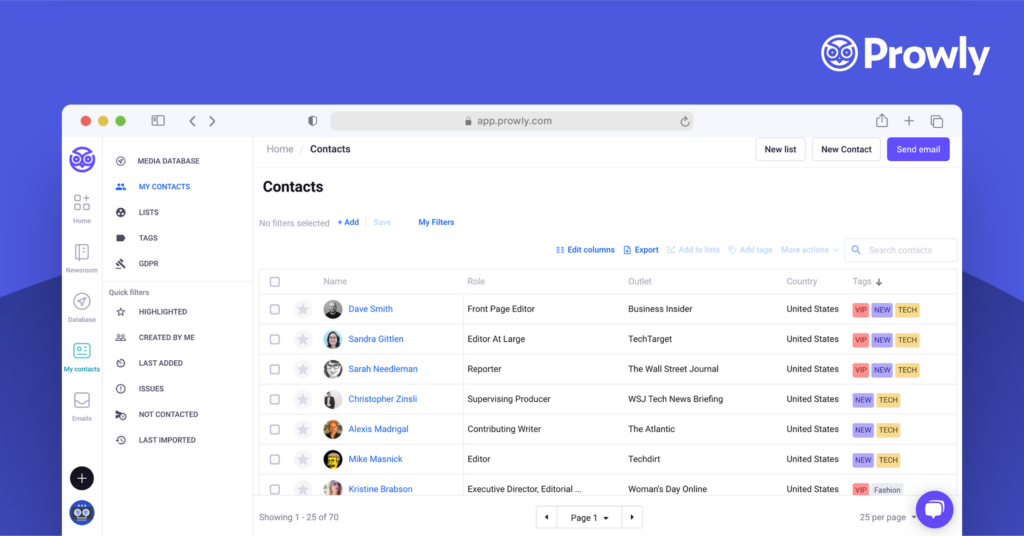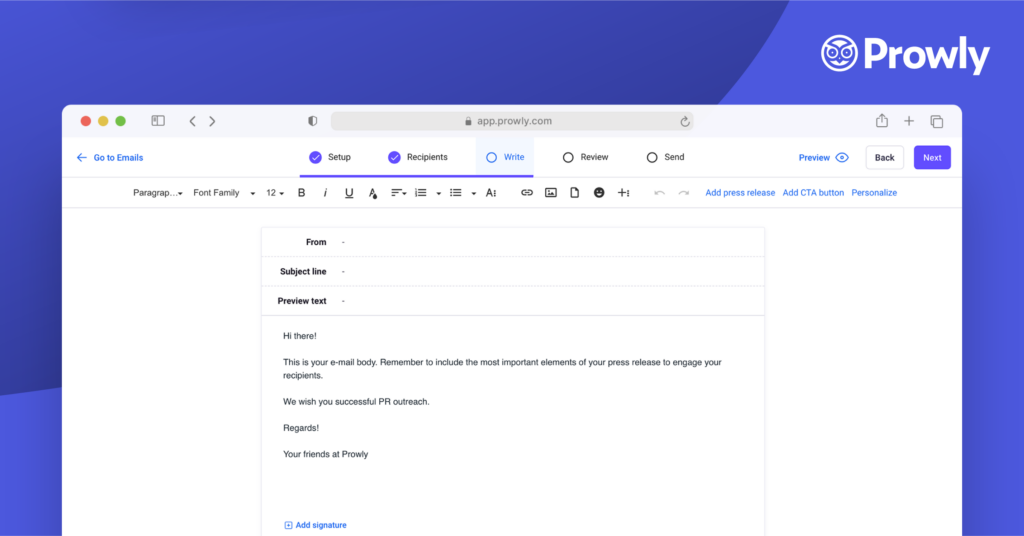Over the years, Customer Relationship Management (CRM) software has seen wide adoption across sales, customer support, and marketing departments. For some reason, CRM tools for PR have only just started gaining traction.
Like most PR practitioners, you might be struggling with keeping your contacts well-organized and up-to-date, especially if you share them with other team members. Without a dedicated CRM for PR (often called a PRM or media relations CRM), you’re also forced to use multiple PR tools at once: spreadsheets, address books, or email platforms, just to name a few. In order to manage media relations properly, you then have to constantly switch between those tools and waste time tracking down or updating your contact information.
If that's the case: the lack of proper public relations CRM might be affecting your relationships with journalists and keeping you from getting media coverage. With CRM tools being one of the biggest software markets in the world, it’s high time PR CRM software starts improving productivity, press contact management, and collaboration for your PR team.
In this article, you'll learn the following:
- What is PR CRM software?
- Why do you need a CRM for PR?
- Press contact management - Best practices from PR experts
- How to choose the best PR CRM tool?
Let’s start with the basics.
What is PR CRM software?
Imagine a powerful tool with all records (including contact details, past interactions, and preferences) of your press contacts perfectly organized. That’s essentially what a PR CRM is.

PRMs are designed to help you keep extensive media contact information from multiple sources in one place. They allow you to organize & keep track of all your media contacts and interactions, without the need to switch between tools and updating data manually. This, in turn, saves you a lot of time and helps in building long-lasting relationships with journalists, which often result in media coverage.
And that’s not everything.
Why is it worth using a CRM for PR?
In sales & marketing departments, CRM software is already known for boosting productivity, creating personalized interactions and fostering customer loyalty, as well as achieving impressive ROI. PR practitioners also have a lot to gain from a dedicated CRM tool:
1. A CRM for PR makes it easy to organize your media lists. With a dedicated PRM, you’re able to segment your contacts, add relevant tags to them, and create targeted media lists to always pitch the right journalists.
2. PR CRMs help you stay on top of your press contacts and interactions. All records and conversations are automatically saved and updated, which means that you always have the most accurate information at hand.
3. A PRM facilitates team collaboration. No more double-pitching, inconsistent communication, or ruined media relationships. With a PR CRM, you know exactly what your PR team has been up to.
4. Public relations CRM helps you make good use of your data. Plenty of PRMs let you use your data more effectively—by giving you the ability to personalize your email pitches, for example).

5. PR CRM can save you a lot of time and energy on media relations management. Using simple PR tools like spreadsheets or address books and constantly jumping between them doesn’t only waste your time, but also keeps you from building meaningful relationships and getting media coverage. With a PR CRM, you can keep everything in one place, and then analyze the results of your media relations management efforts to make more informed decisions in the long run.
Press contact management - Best practices from PR experts
Even with a proper media relations CRM, you still need to organize your contacts to be able to build & foster your media relationships. To help you get started, I asked PR experts for their best practices when it comes to press contact management. Here's what they answered.
Be smart about the details you keep
You can't have too much information. I always keep a general notes section where I can keep track of birthdays, hobbies, or anything of interest that comes up organically. I don't intentionally ask them for their birthday, but if it comes up, I'll make a note. Otherwise, I make sure I have general contact details and the media outlets they represent. I try to feel out someone's style of communication—if they aren't very talkative, keeping your contact to the point will probably earn you more respect with them. - Kirsten McKinney, Digital Growth Mastery
Use tags and labels
To give you an example, here’s how my contacts are labeled:
First name, Last name, Outlet, Job title, Subject, Contact details (email, phone), Social media handles, Publication audience reach, Unique Viewers per Month, The date of the last communication (if any), Notes.
Each contact spreadsheet is then organized by either an outlet or a topic. For example, with my health & wellness client, I have spreadsheets for Woman’s Health, Fitness Mag, Mind, Body, Green, and other relevant publications. I also have spreadsheets organized by a topic, such as “Meditation,” “Mental Health,” “Family,” “Women’s Health,” etc.
This allows me to organize media contacts not only by where they work, but also by the specific topics they cover, so I know I am always pitching the right people. I do use PR CRM software to import these lists, and I recommend all PR Pros purchase media database software of some sort. It is impossible to garner the hundreds of thousands of contacts you will need throughout your career by hand. - Jennifer Mancini, Mancini Media Strategy
Track your interactions
In addition to the name, email address, title, and outlet - note specific beats, notable articles, and track interactions you have with them. If your records show you haven't touched base in a while, reach out to grab a coffee or have a quick phone call. It's a great way to make sure you're up to date on what topics they're covering and let them know how you can be used as a source. - Cassie Scher, Vice President @ Nahigian Strategies
Segment your contacts
We’ve found a lot of success using tags to organize contacts and segment media lists based on coverage area. This allows us to target the writers that we’ve worked with previously first, and then move on to other contacts that also cover the same coverage area. Investing in a platform that does a lot of the heavy lifting for you will allow you to be more efficient in targeting more contacts in a shorter period of time, scale this process for multiple clients, and improve your results. - Matthew Zajechowski, Outreach Team Lead @ Digital Third Coast
Add new contacts meticulously
When I get a new contact, I try to fill out some details about them, so I know where they fit into my contacts list. I map out their details but one of the most important aspects for me is to get how they like to receive content. This is one of the most important things to note from the off and this is how I like to view my list, so I know from the get-go what I need to do. Once I get to know the journalist well, I add more details. - Sandra Coffey, Publicity Strategist
Keep updating your media lists
Monitor and stay on top of any company changes that might happen in the media outlets you're trying to reach. 90% of managing a media list is updating it, which will only increase your chances of success. I also like to organize my media contacts through the level of importance and reader base. After all, you want to reach the outlets that will speak to your target audience. - Elena Schelfhaut, freelance PR manager
Don’t treat your contacts as faceless records in your media relations CRM
As a former reporter myself, my biggest tip is to view these contacts as people who have an important job and mission, not just as pitches who can help you help your client. We know that the media is a fluid entity, and it's important to recognize that we are providing a valuable service to them and our clients. We never want a contact to feel like a faceless number in a system, which is why we never do press releases or mass data overhauls, or some of the more traditional media methods. I know what it's like to receive hundreds of mass pitches, so we are striving to do better. - Dana Stein, Senior VP of Public Relations @ Pink Shark PR
With these PR tips, managing press contacts should get much easier. The question remains, however:
How to choose the best PR CRM?
Before you start researching and trying out different PR tools, ask yourself:
- How big and organized is your contact list?
- What other PR activities do you want to streamline with a PRM?
- How many people are going to use the PR CRM software?
- What is your budget?
Every PR team is unique and might find different PR tools better. Knowing the answers should help you narrow down your choices and, eventually, choose the best CRM for your PR needs.
When making the decision, you should also consider the following:
Go after the features you really need
PR CRM tools come with a lot of functions but it’s likely that you won’t be using all of them. In fact, research shows that first-time CRM buyers often overestimate the features they actually need. Don’t simply go for “all-in-one” PR tools, but choose a PR CRM that can suit your needs—there’s no point in paying for something that you’re not going to take advantage of.
Compare the costs of different PR CRM tools
The cost of PR software varies greatly and often depends on several factors, such as the availability of features or the number of users. Since some PR CRM tools come with quite expensive and long-term contracts, it makes sense to think of your needs and budget first before you start comparing different solutions.
Leverage free trials of shortlisted PRMs
Many vendors offer free trials and personalized demos, which you should definitely leverage. These will not only help you see the chosen PR CRM tools in action but also figure out how exactly they can suit your PR needs before making any commitments.
Pay attention to user experience
Easiness of use is what many professionals look for in a CRM—and rightly so. PR CRM software is supposed to help you save time and energy, not make your job more difficult. Choose a PRM that’s intuitive and offers the best user experience possible. If there’s anything that irritates you or slows you down, you might want to look elsewhere.
Check whether there’s a training session included in the price
Without proper configuration, training, and support, it might be difficult to make the most of your media relations CRM in the long run. Try to assess the quality of customer support and knowledge base during the free trial, and check whether there’s a personalized onboarding session included in the price.
Choose a CRM that meets your PR requirements
To cut a long story short: public relations CRM means more effective press contact management, which results in better relationships with specific journalists & media outlets, and helps you gain wider coverage. Instead of trying to figure out whether you need a PR CRM, then, you should focus on how to choose the best CRM that meets your PR requirements.
Even though PR CRM tools are fairly new on the market, there’s already a variety of PRMs out there. When choosing the best software for your PR needs, make sure it can ease all your press contact management efforts, including:
- Managing your media contacts
- Finding new connections to add to your contact list
- Segmenting and organizing all your records
- Creating targeted media lists
- Sending personalized email pitches
- Measuring the results of your pitches
- Planning follow-ups
Not to brag, but you can do all of these PR activities (and more) in Prowly. It’s a comprehensive media relations tool with an intuitive user interface, great customer support, and affordable pricing plans. See it for yourself.
Cover photo by Jen Theodore
